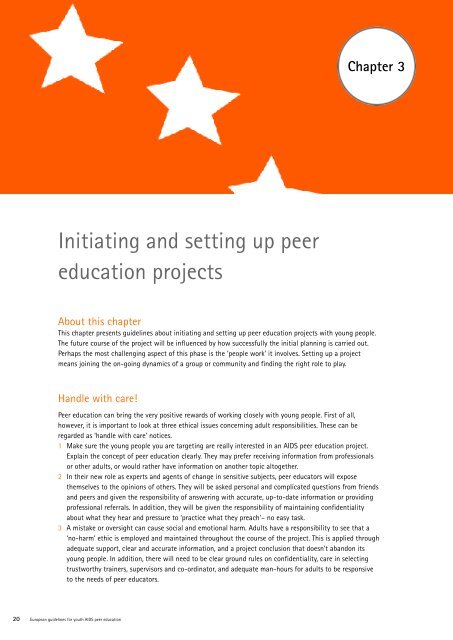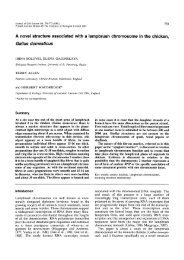Project evaluation – a policy questionOne <strong>of</strong> the main issues surrounding <strong>peer</strong> <strong>education</strong> is the lack <strong>of</strong> evaluation literature. This affects policymaking because it makes decision making and prioritisation difficult. There are several factors contributing tothis situation, including the ‘gap’ between practitioners and researchers, the wide variation in the use <strong>of</strong> theterm <strong>peer</strong> <strong>education</strong>, and that <strong>AIDS</strong> <strong>peer</strong> <strong>education</strong> is a relatively new and innovative approach.Practitioners vs. evaluatorsPractitioners are those who work directly with young people, setting up and supporting <strong>peer</strong> <strong>education</strong>projects. They meet young people on a person-to-person basis and their knowledge is grounded in first-handin<strong>for</strong>mation about and experience <strong>of</strong> the lives <strong>of</strong> young people. They use their knowledge, experience andintuition to figure out what needs to be done and then do it. Practitioners may feel policed or supervised byoutside evaluators, and may regard their involvement in programmes with suspicion. The theoreticalmethods evaluators use and the controlled conditions they employ may be seen as impractical.Traditionally, evaluators and researchers remain objective by working from theory and scientific evidence. Ahierarchical model <strong>of</strong> knowledge has developed which assumes that theory and research exist on a higherplane, and trickles down to practitioners. Difficulties in collaboration and the sharing <strong>of</strong> skills betweenpractitioners and evaluators, and agencies and universities, contributes to the lack <strong>of</strong> evaluation literature 6 .Moreover long delays can take place between real world practice and the eventual reporting <strong>of</strong> researchresults. During the lapse, practitioners and the <strong>peer</strong> educators have learned from experience and moved on.This makes <strong>peer</strong> <strong>education</strong> a ‘moving target’.Policy making can encourage collaboration between universities, practitioners and citizens. Seminars,workshops, and training programmes on evaluation methods and reporting <strong>for</strong> practitioners can be arranged atnational, regional and local levels. In the long term, this will contribute to individual project development andprovide faster feedback on new and innovative approaches like <strong>peer</strong> <strong>education</strong>. The Evaluation chapter <strong>of</strong> these<strong>guidelines</strong> continues this discussion in greater depth and attempts to provide some practical solutions.To ease their decision making, policy-makers can create networks where young people, practitioners,researchers, and themselves share experience and gain awareness <strong>of</strong> each other’s perspectives.Chapter 21 WHO Regional Office <strong>for</strong> Europe. Health promotion and health care systemsre<strong>for</strong>ms - a consensus statement. WHO Regional Office <strong>for</strong> Europe; 1995.2 <strong>European</strong> Commission. Community action programme ‘Europe against <strong>AIDS</strong>’:Directorate general V, <strong>European</strong> Commission; 1996 Internal reference no.:CE-V/3-97-003-N/FR-C.3 Hart R. Children’s participation: from tokenism to citizenship. Innocenti Essays;No. 4; New York, NY: UNICEF; 1992.4 Sustainable Agriculture Programme. PLA Notes, No. 25. London: InternationalInstitute <strong>for</strong> Environment and Development; 1996.5 <strong>European</strong> Commission. <strong>European</strong>s and <strong>AIDS</strong>: results <strong>of</strong> the Eurobarometerssurveys 43.0 et 43.1. Bruxelles: <strong>European</strong> Commission; 1996.6 McCarett Hess P, Mullen EJ, editors. Practitioner-researcher partnerships: buildingk n owledge from, in and <strong>for</strong> practice. Washington, DC: NASW Press; 1995.<strong>European</strong> <strong>guidelines</strong> <strong>for</strong> <strong>youth</strong> <strong>AIDS</strong> <strong>peer</strong> <strong>education</strong> 19
Chapter 3Initiating and setting up <strong>peer</strong><strong>education</strong> projectsAbout this chapterThis chapter presents <strong>guidelines</strong> about initiating and setting up <strong>peer</strong> <strong>education</strong> projects with young people.The future course <strong>of</strong> the project will be influenced by how successfully the initial planning is carried out.Perhaps the most challenging aspect <strong>of</strong> this phase is the ‘people work’ it involves. Setting up a projectmeans joining the on-going dynamics <strong>of</strong> a group or community and finding the right role to play.Handle with care!Peer <strong>education</strong> can bring the very positive rewards <strong>of</strong> working closely with young people. First <strong>of</strong> all,however, it is important to look at three ethical issues concerning adult responsibilities. These can beregarded as ‘handle with care’ notices.1 Make sure the young people you are targeting are really interested in an <strong>AIDS</strong> <strong>peer</strong> <strong>education</strong> project.Explain the concept <strong>of</strong> <strong>peer</strong> <strong>education</strong> clearly. They may prefer receiving in<strong>for</strong>mation from pr<strong>of</strong>essionalsor other adults, or would rather have in<strong>for</strong>mation on another topic altogether.2 In their new role as experts and agents <strong>of</strong> change in sensitive subjects, <strong>peer</strong> educators will exposethemselves to the opinions <strong>of</strong> others. They will be asked personal and complicated questions from friendsand <strong>peer</strong>s and given the responsibility <strong>of</strong> answering with accurate, up-to-date in<strong>for</strong>mation or providingpr<strong>of</strong>essional referrals. In addition, they will be given the responsibility <strong>of</strong> maintaining confidentialityabout what they hear and pressure to ‘practice what they preach’– no easy task.3 A mistake or oversight can cause social and emotional harm. Adults have a responsibility to see that a‘no-harm’ ethic is employed and maintained throughout the course <strong>of</strong> the project. This is applied throughadequate support, clear and accurate in<strong>for</strong>mation, and a project conclusion that doesn’t abandon itsyoung people. In addition, there will need to be clear ground rules on confidentiality, care in selectingtrustworthy trainers, supervisors and co-ordinator, and adequate man-hours <strong>for</strong> adults to be responsiveto the needs <strong>of</strong> <strong>peer</strong> educators.20 <strong>European</strong> <strong>guidelines</strong> <strong>for</strong> <strong>youth</strong> <strong>AIDS</strong> <strong>peer</strong> <strong>education</strong>
















